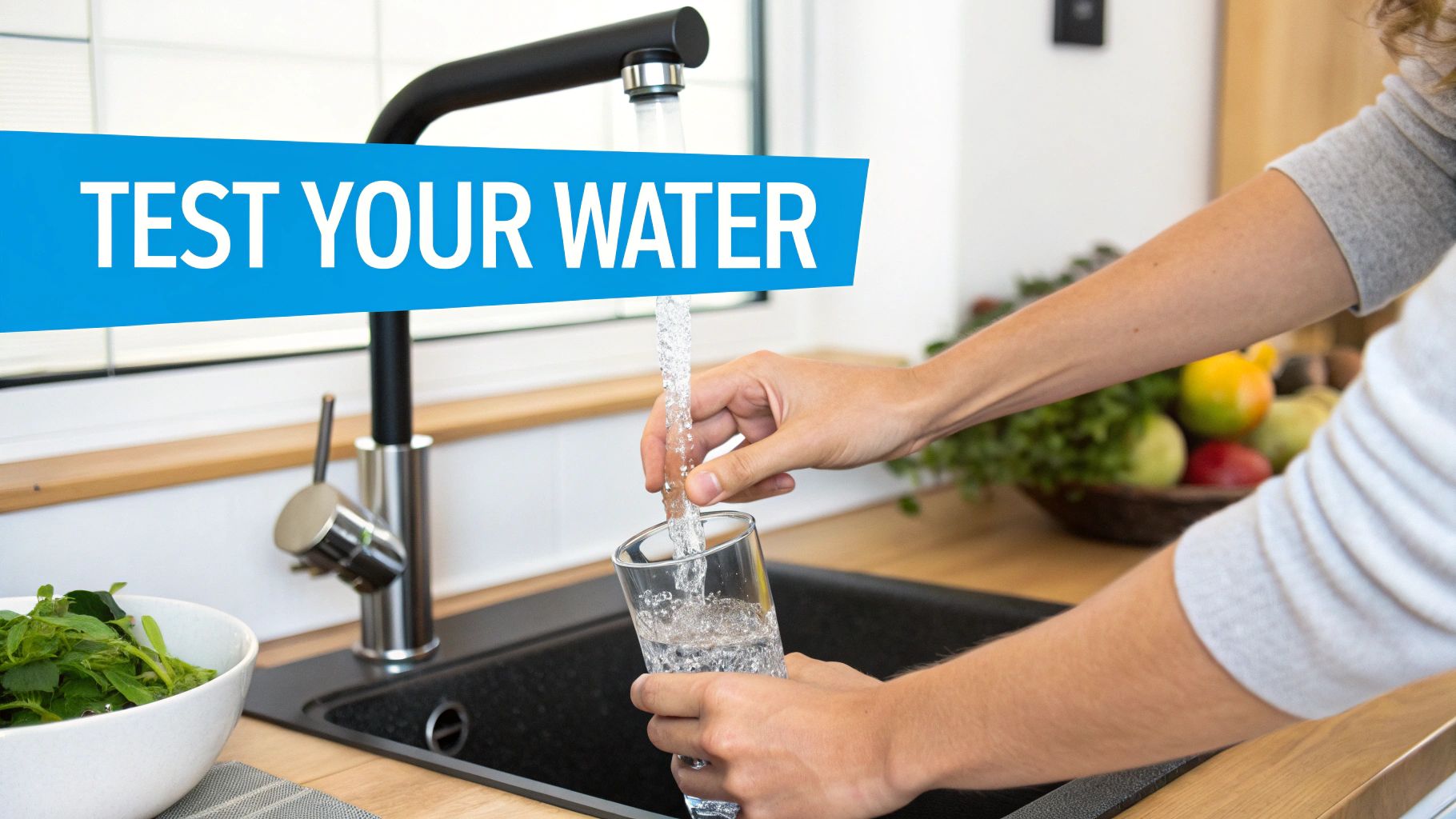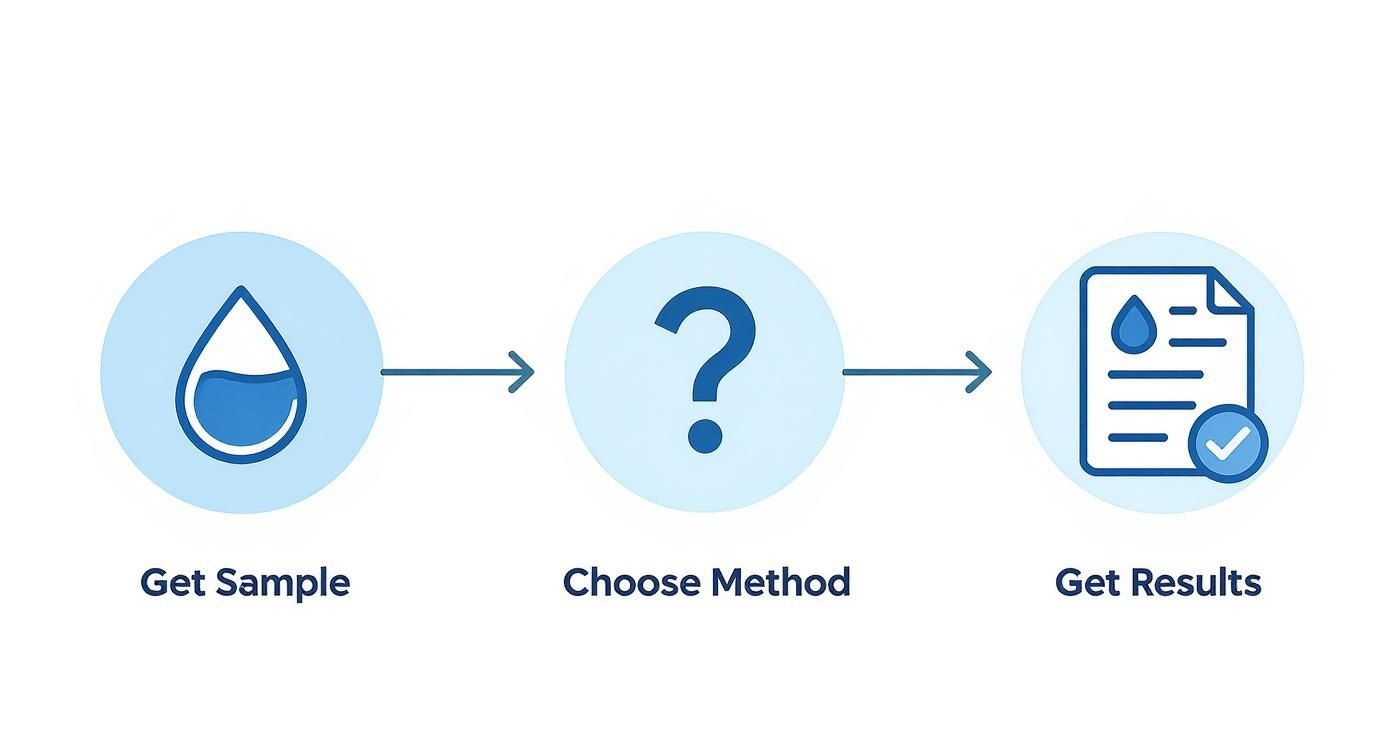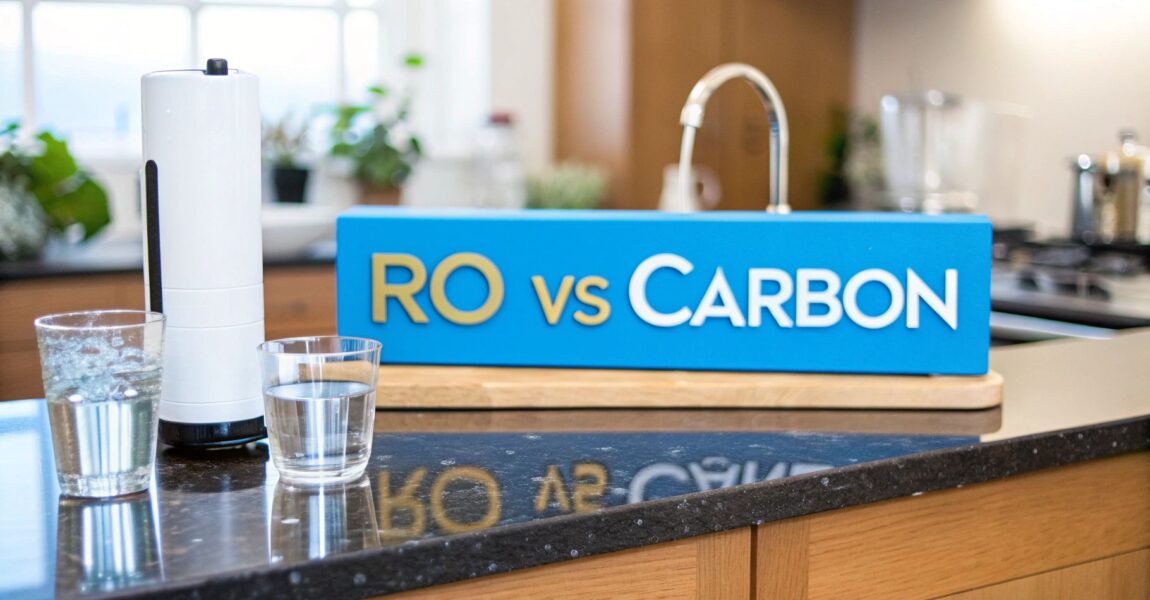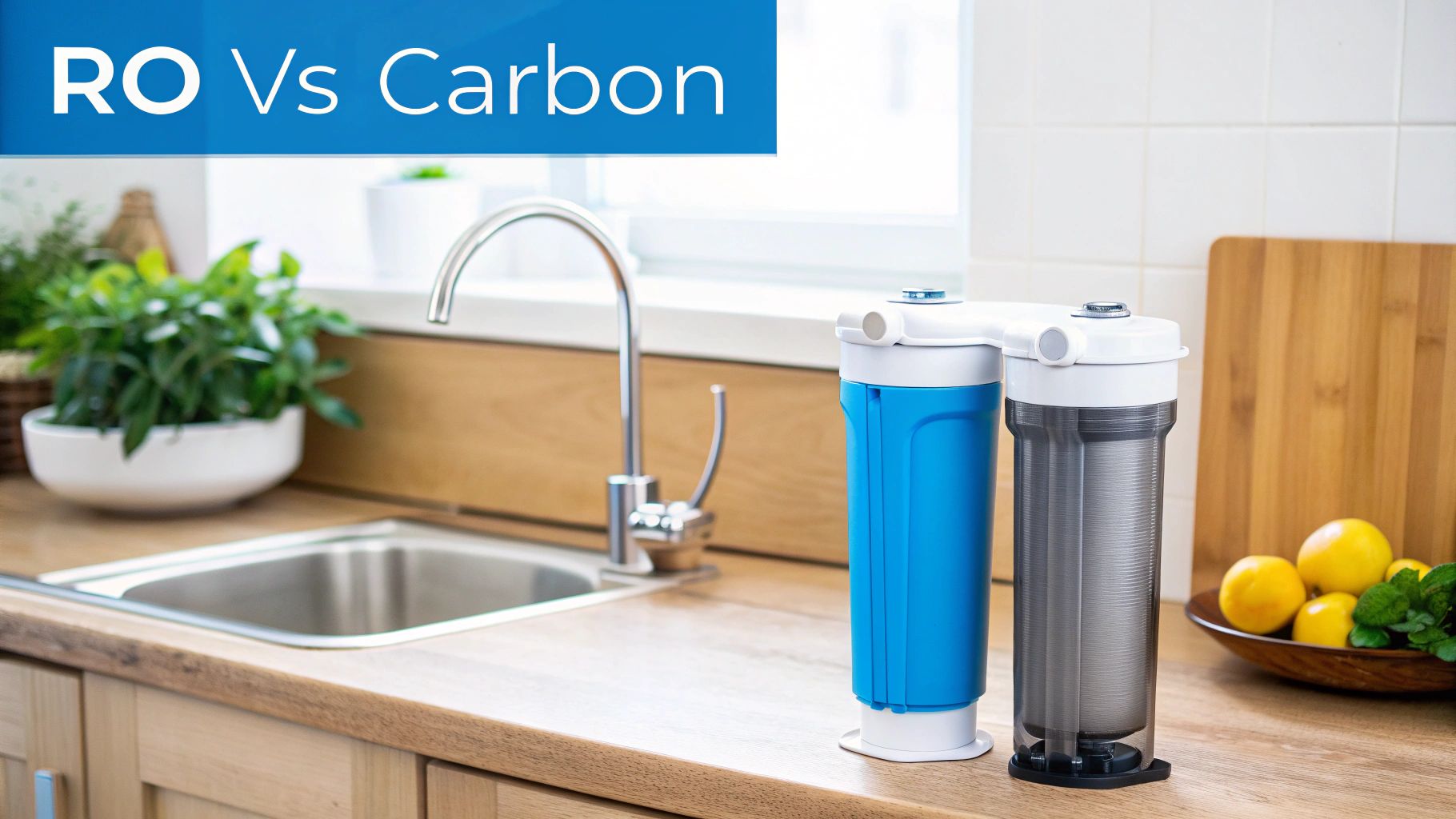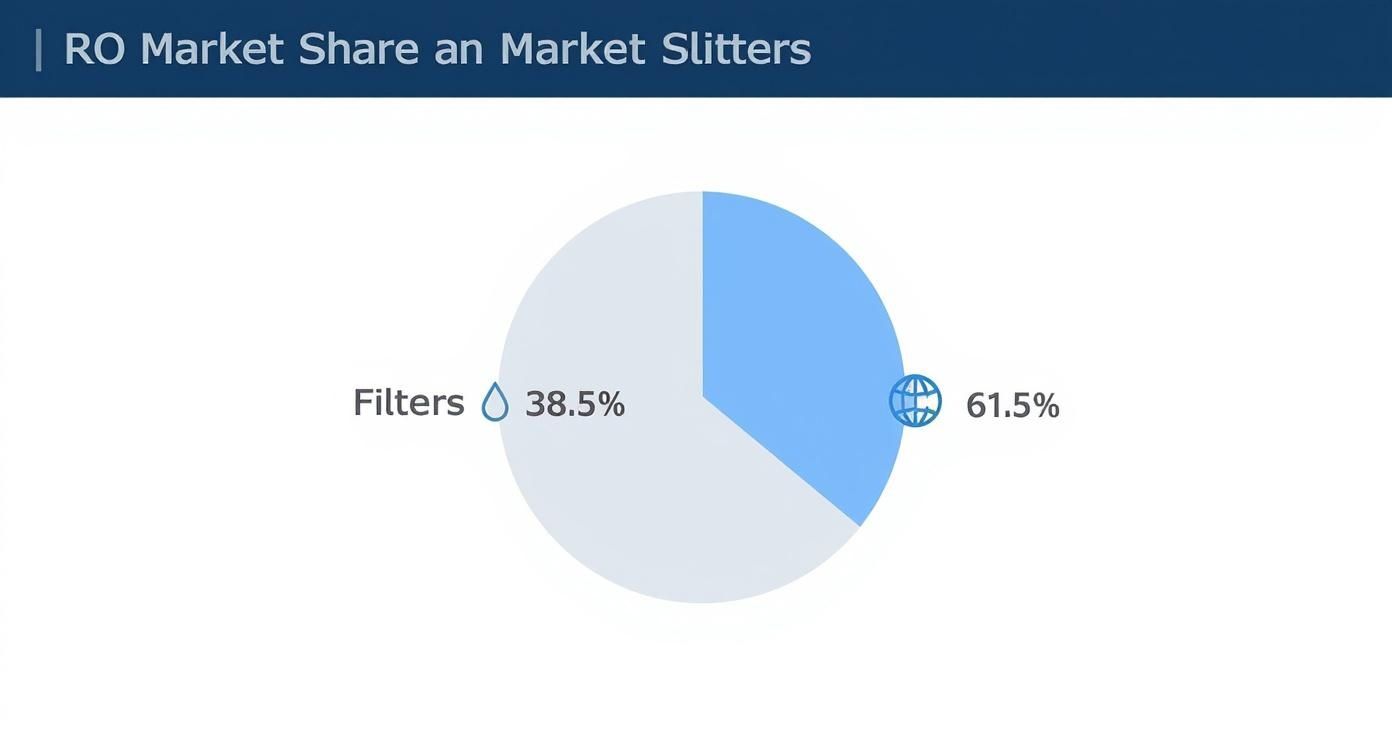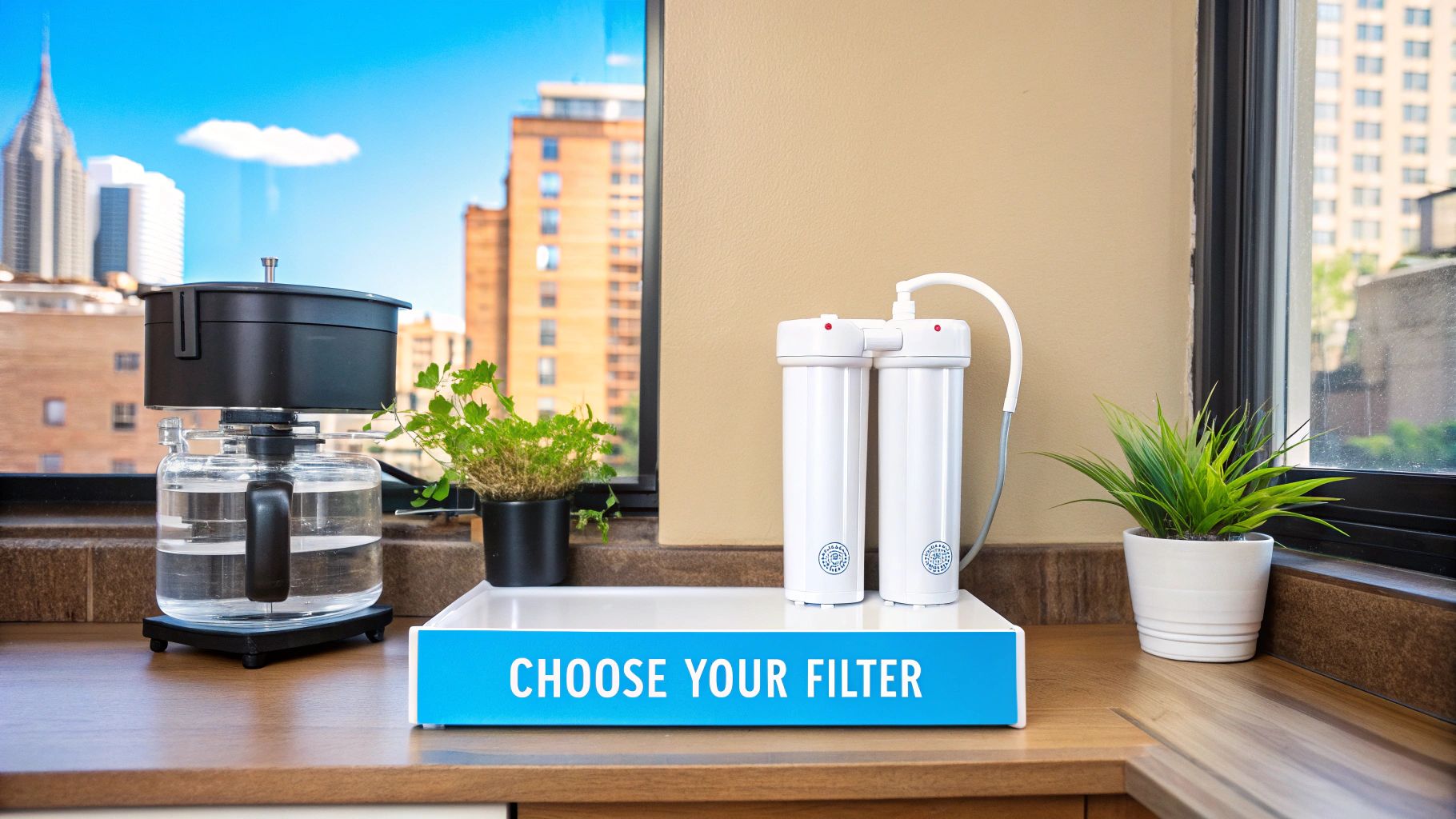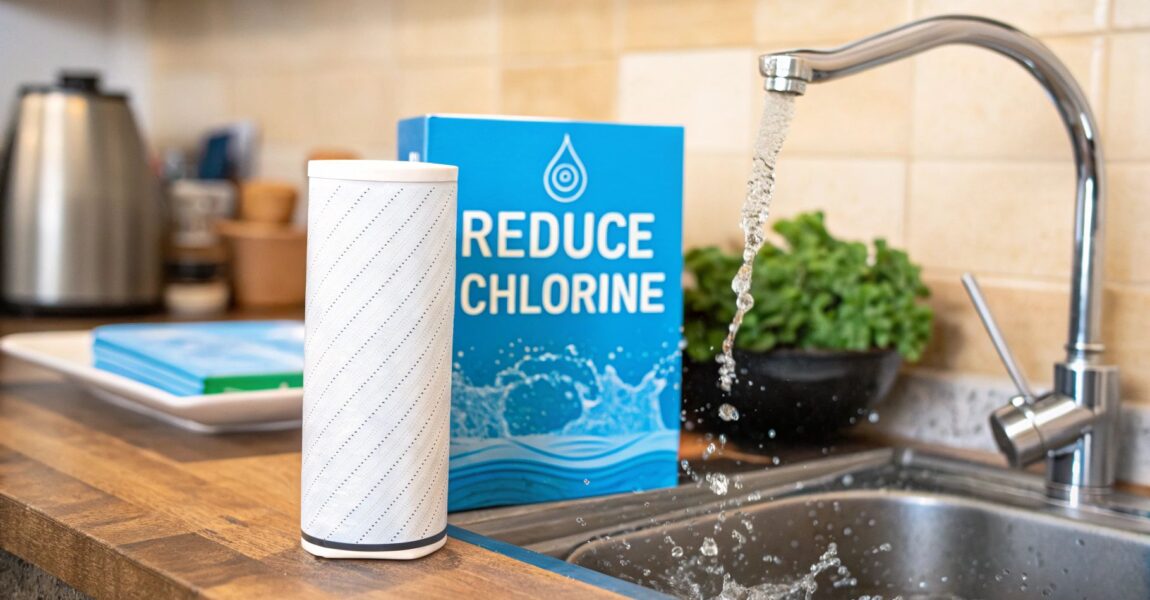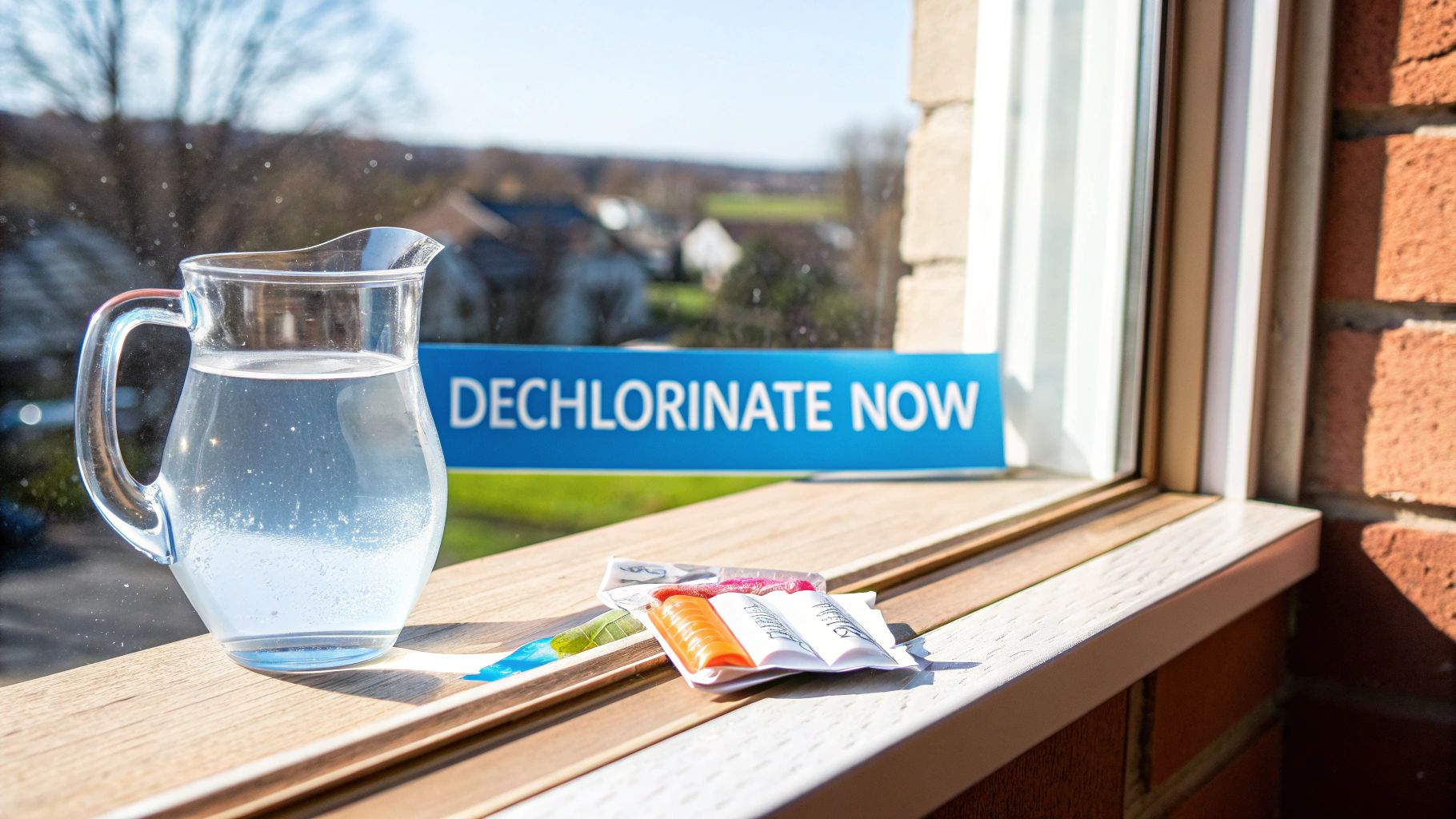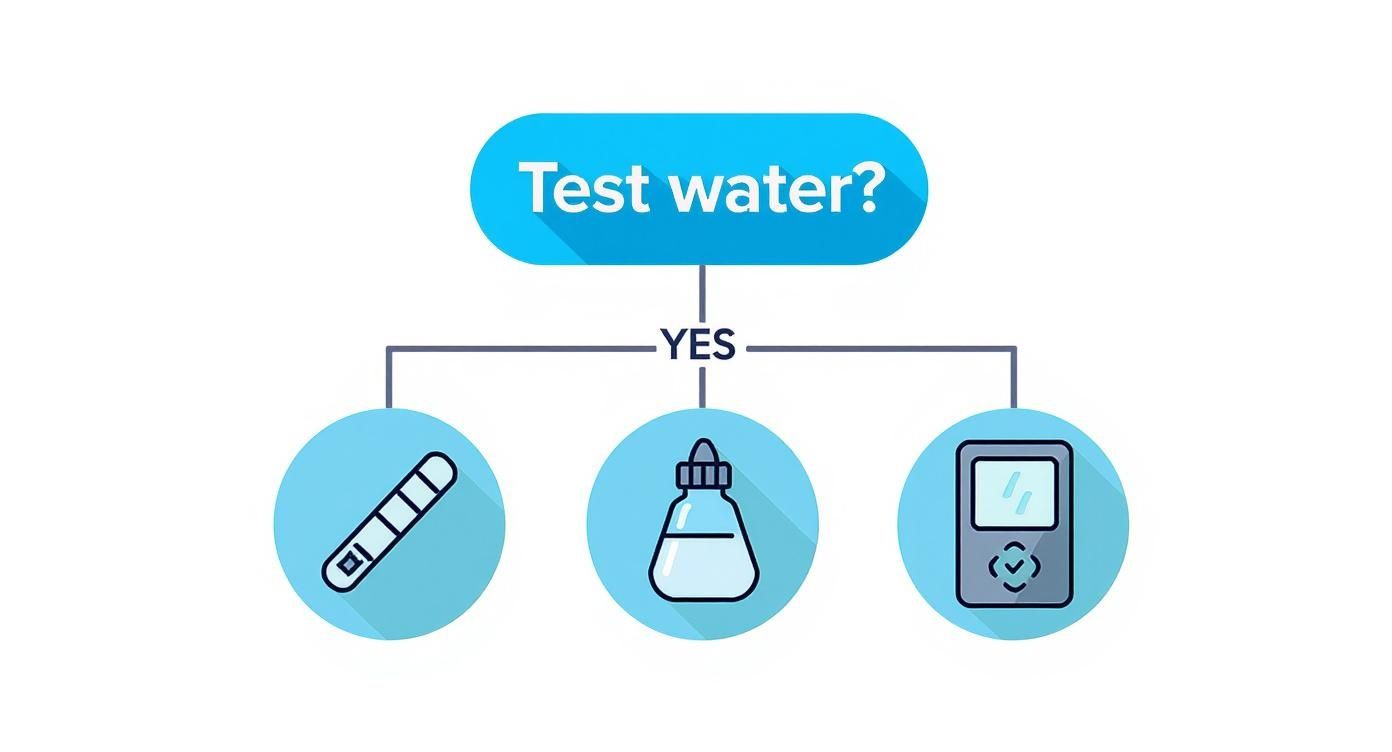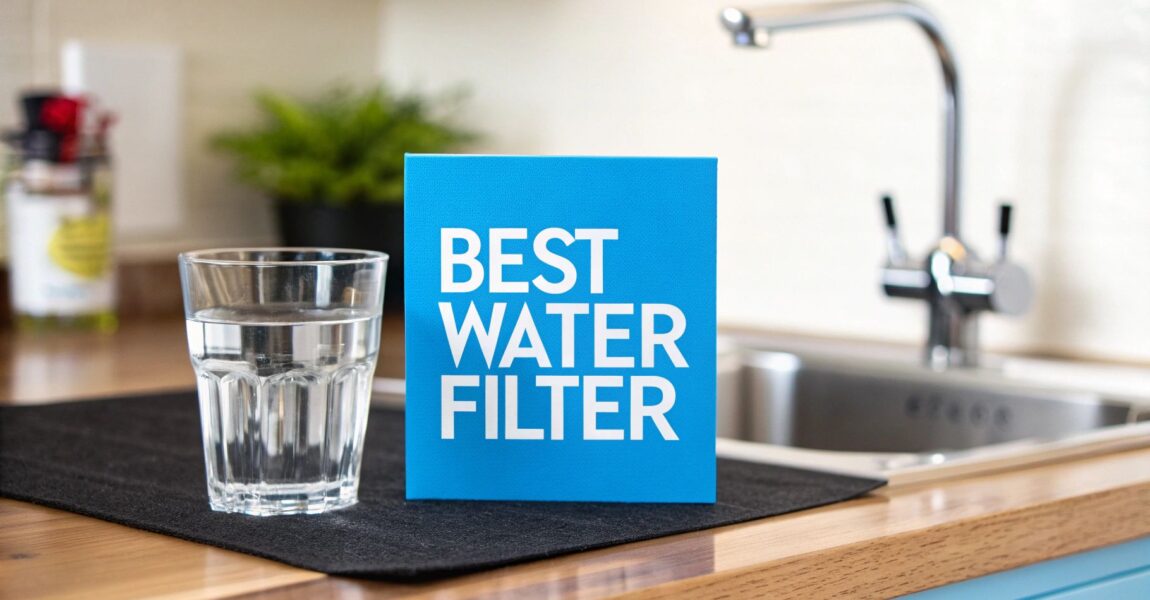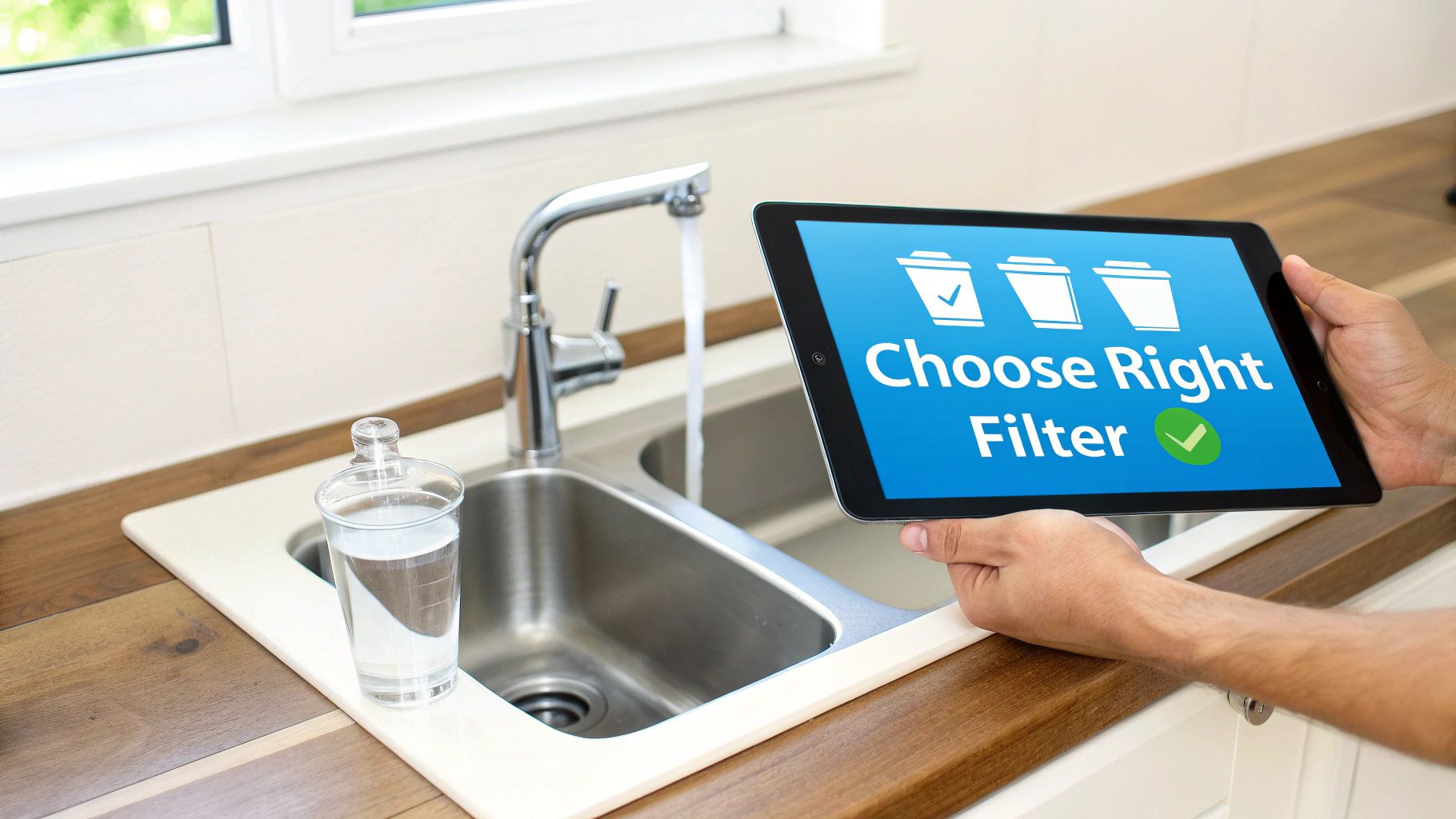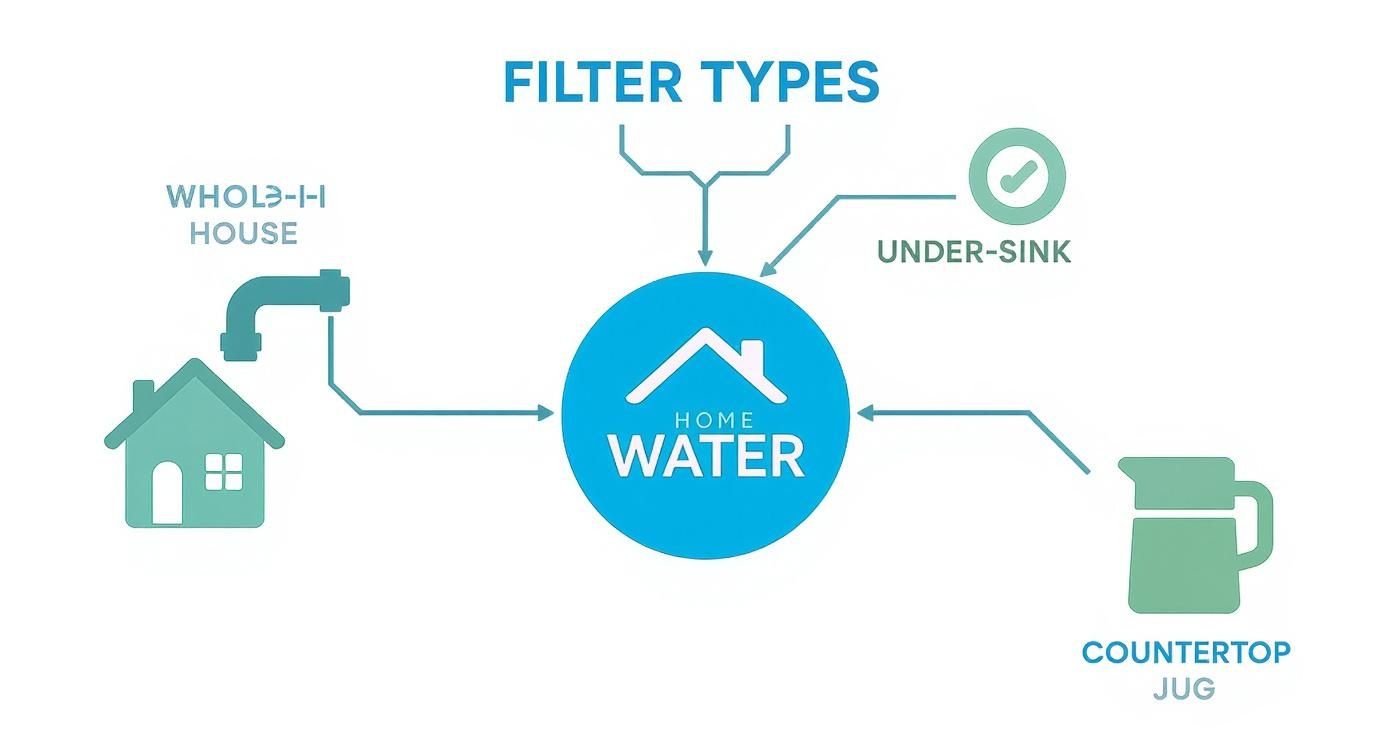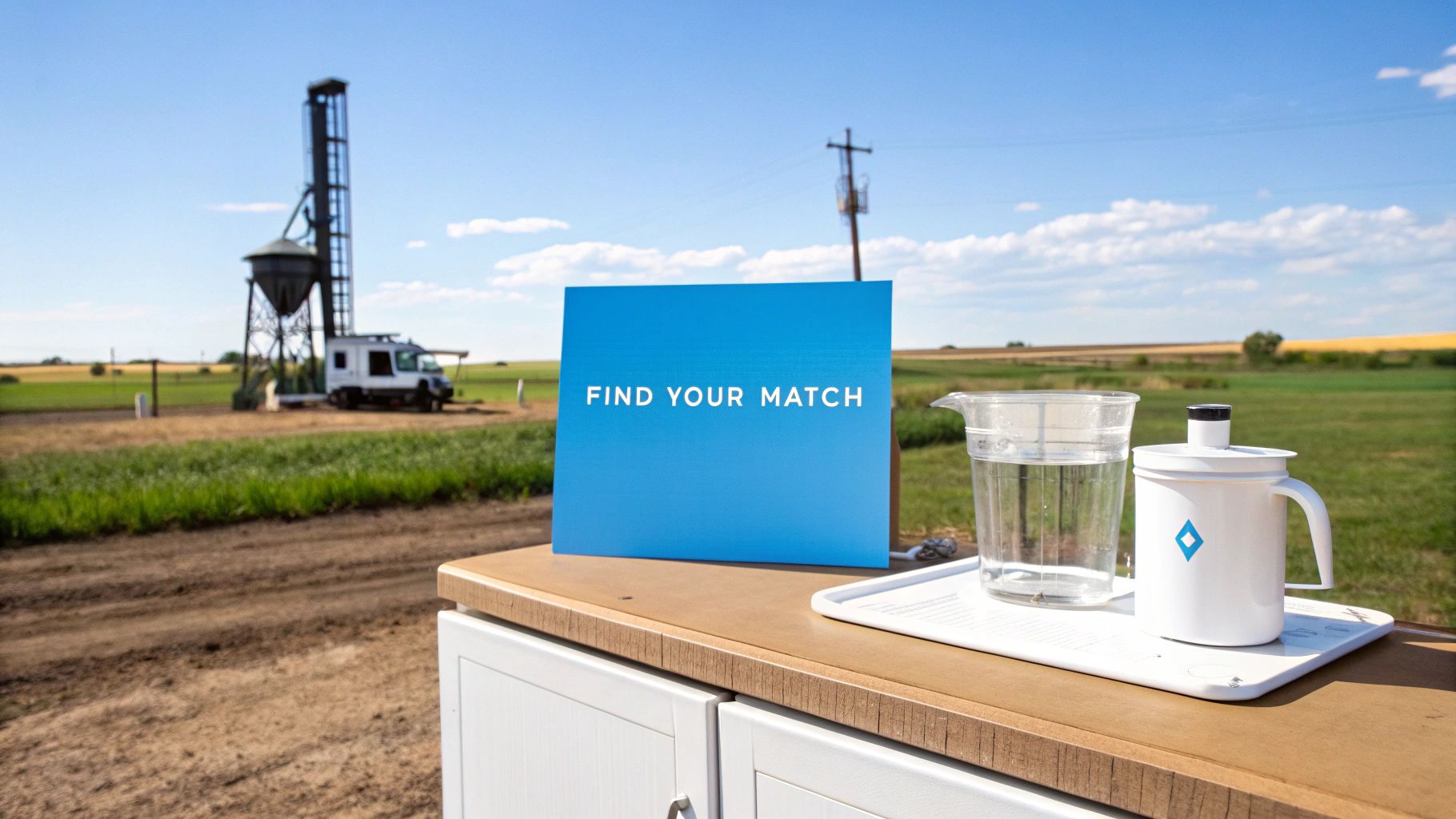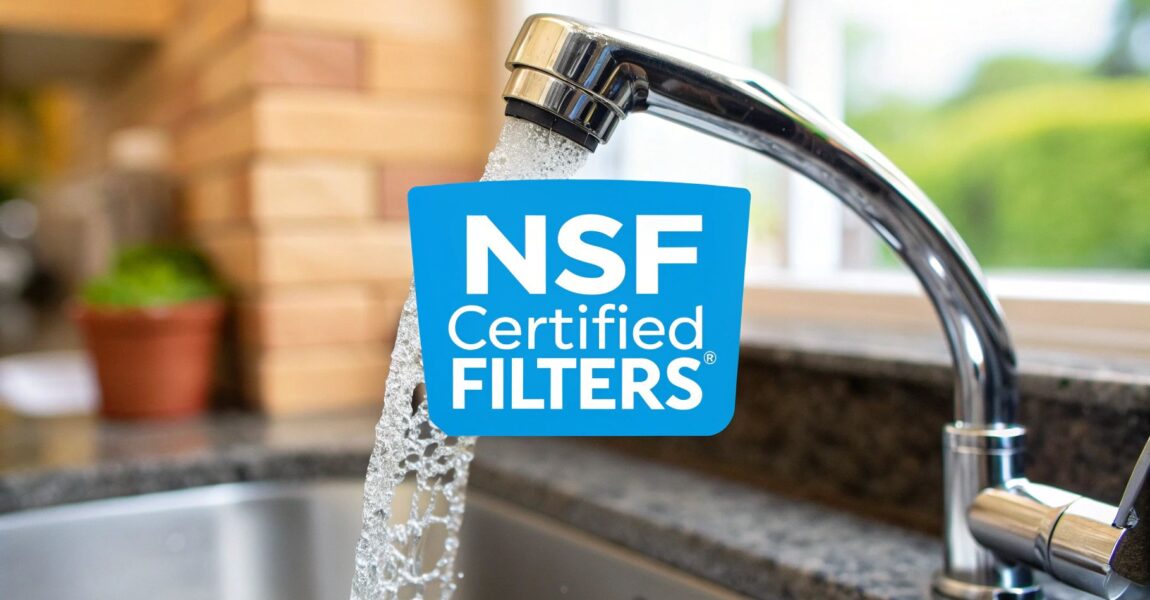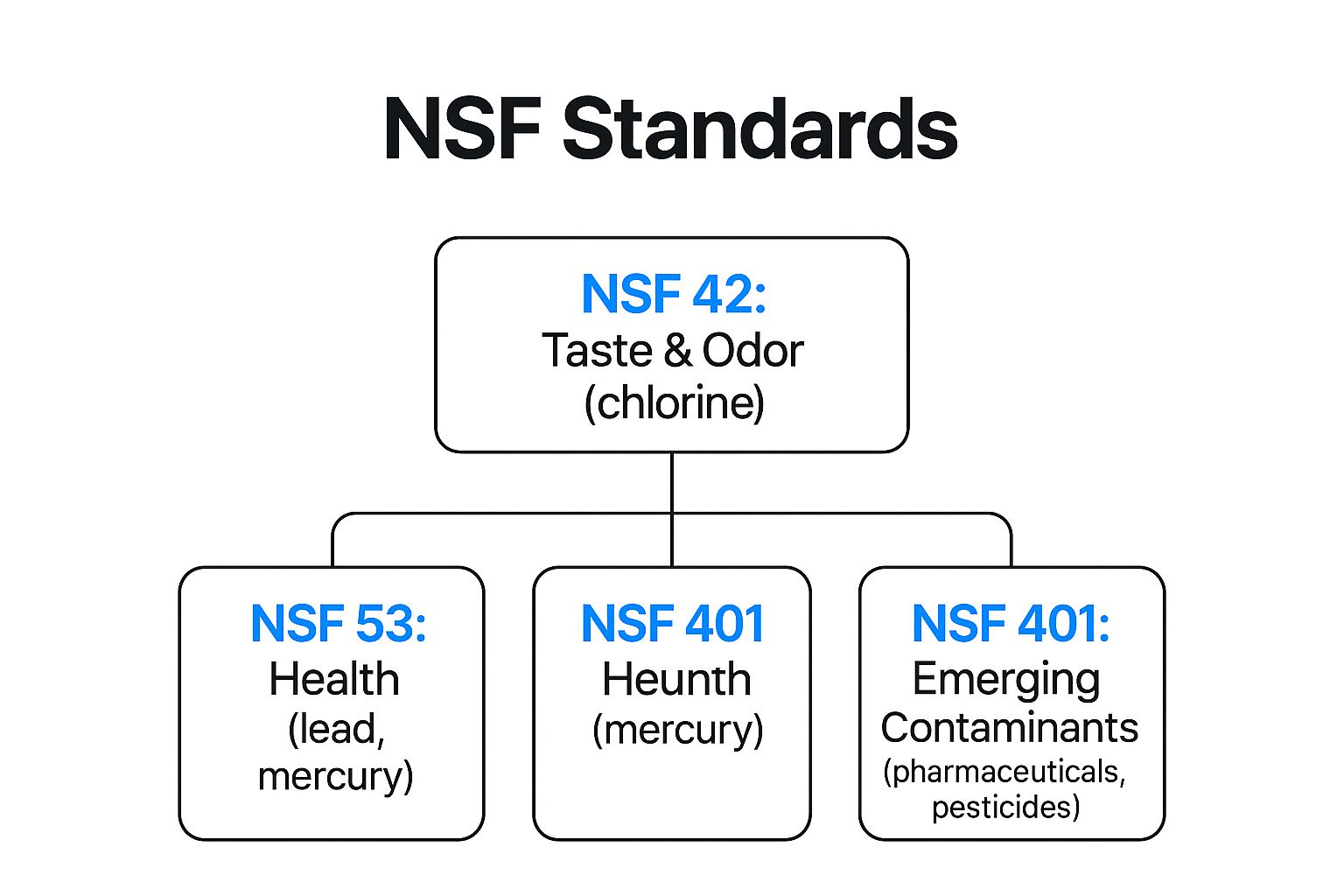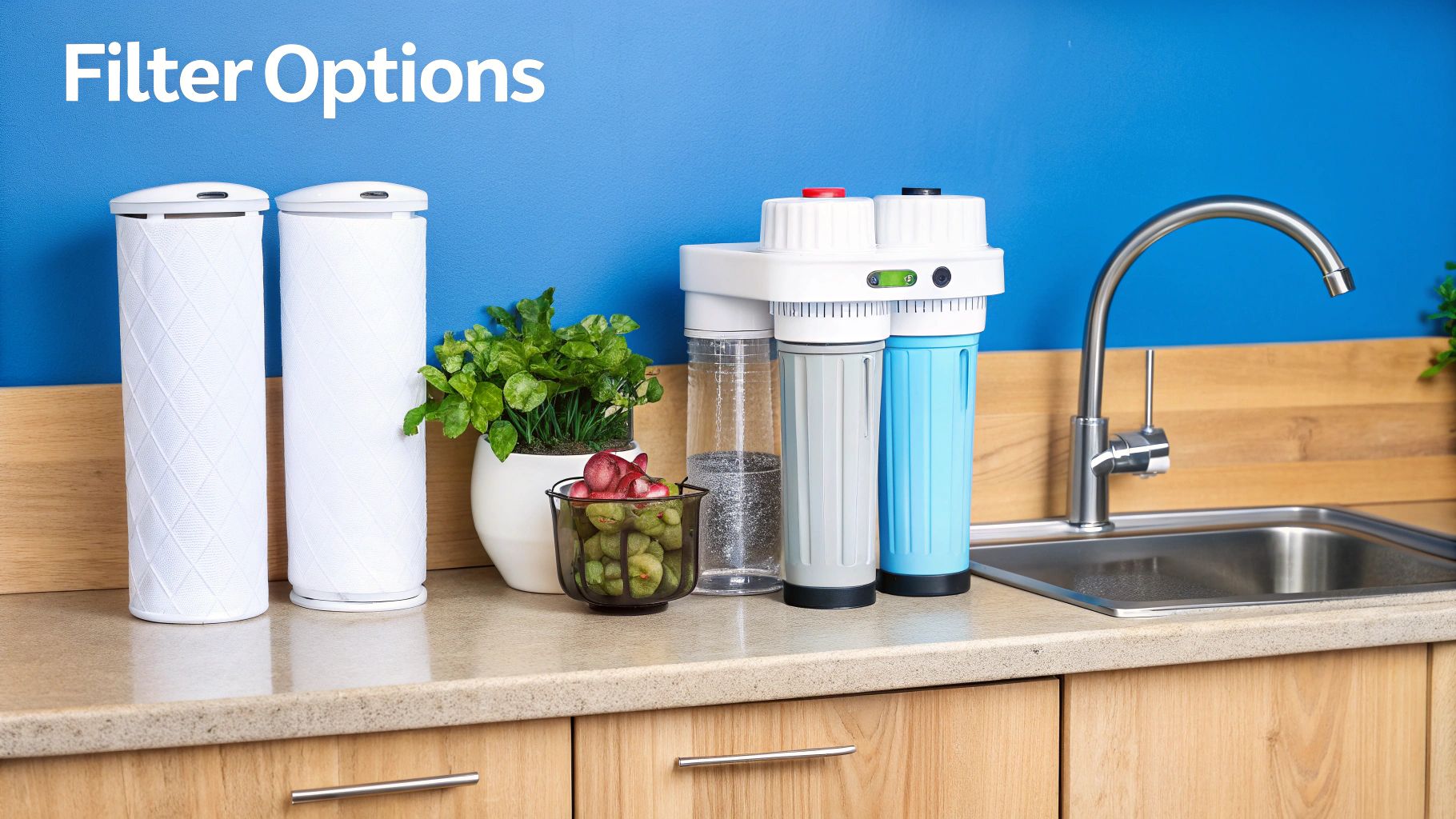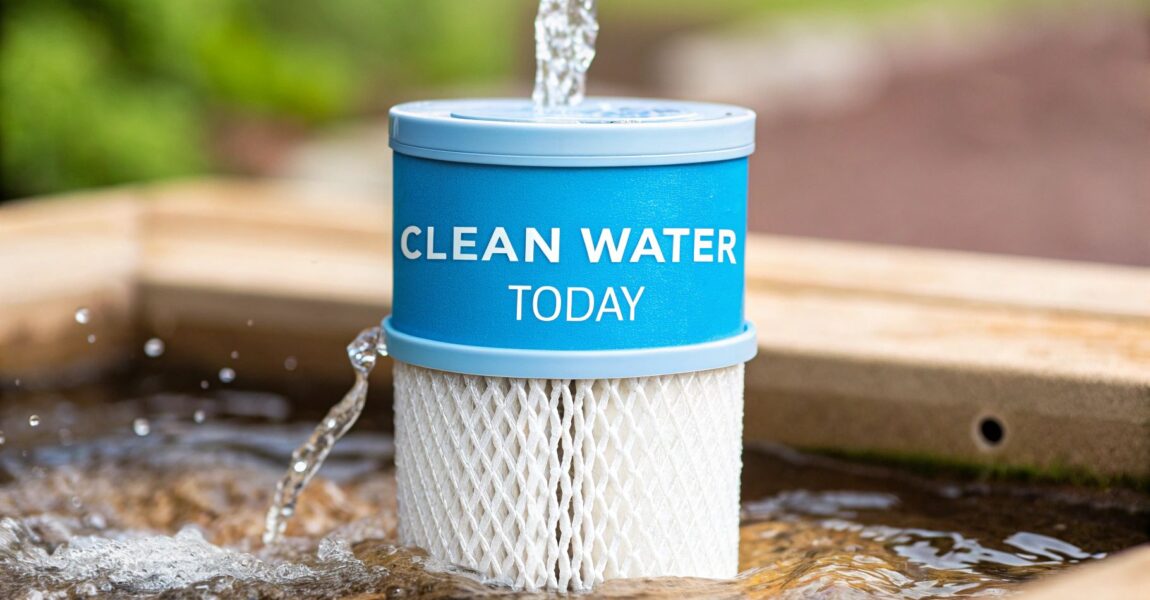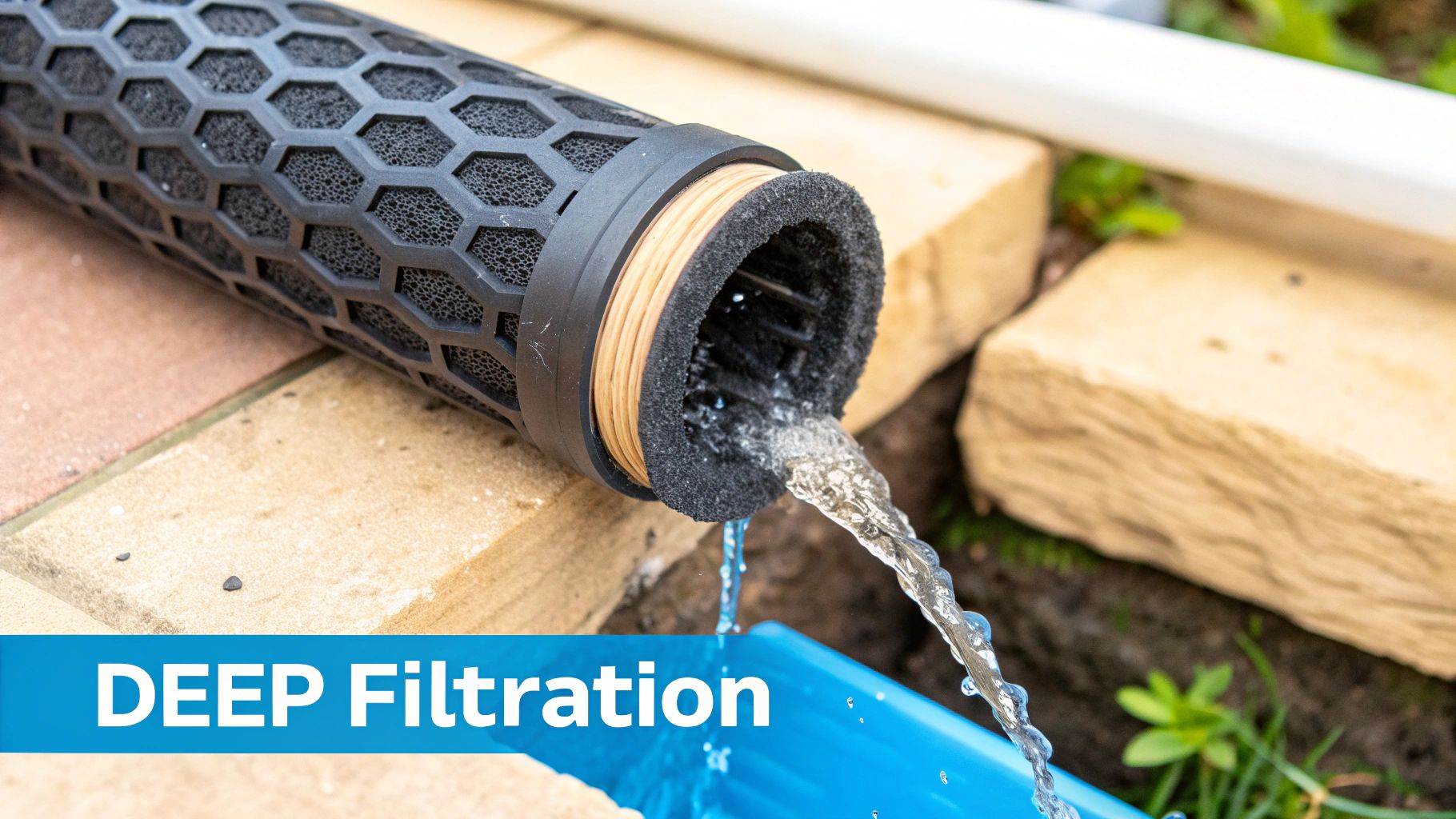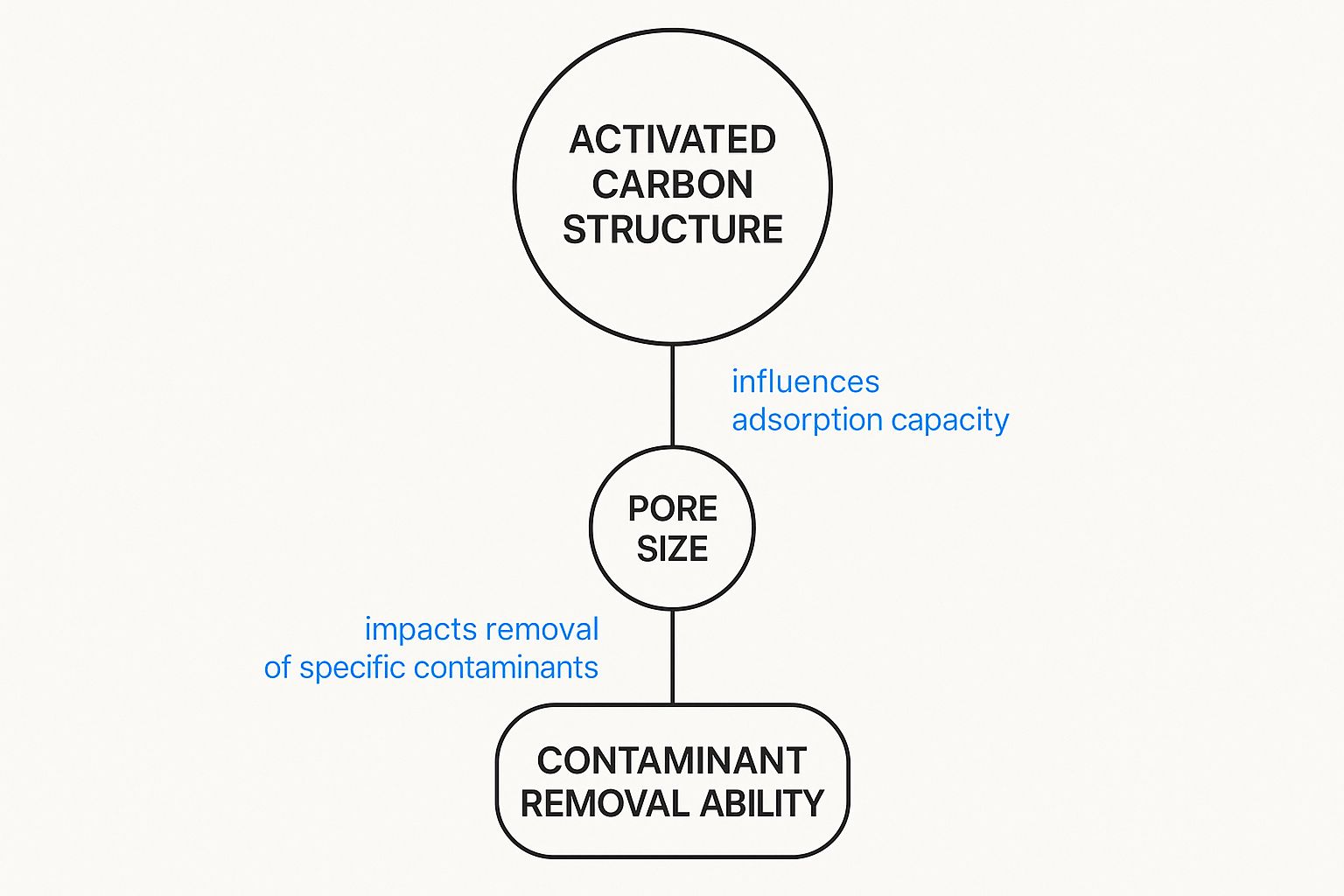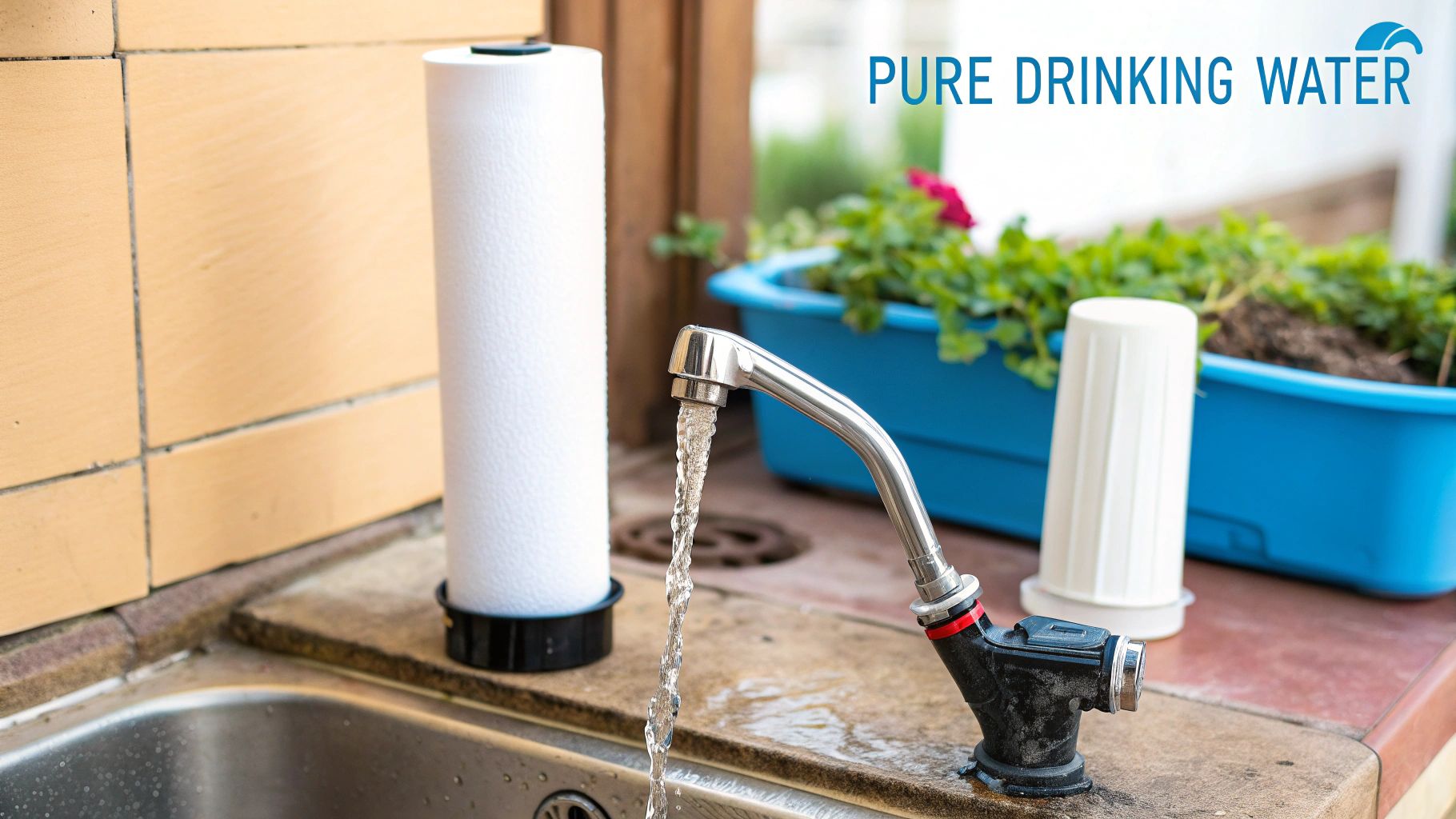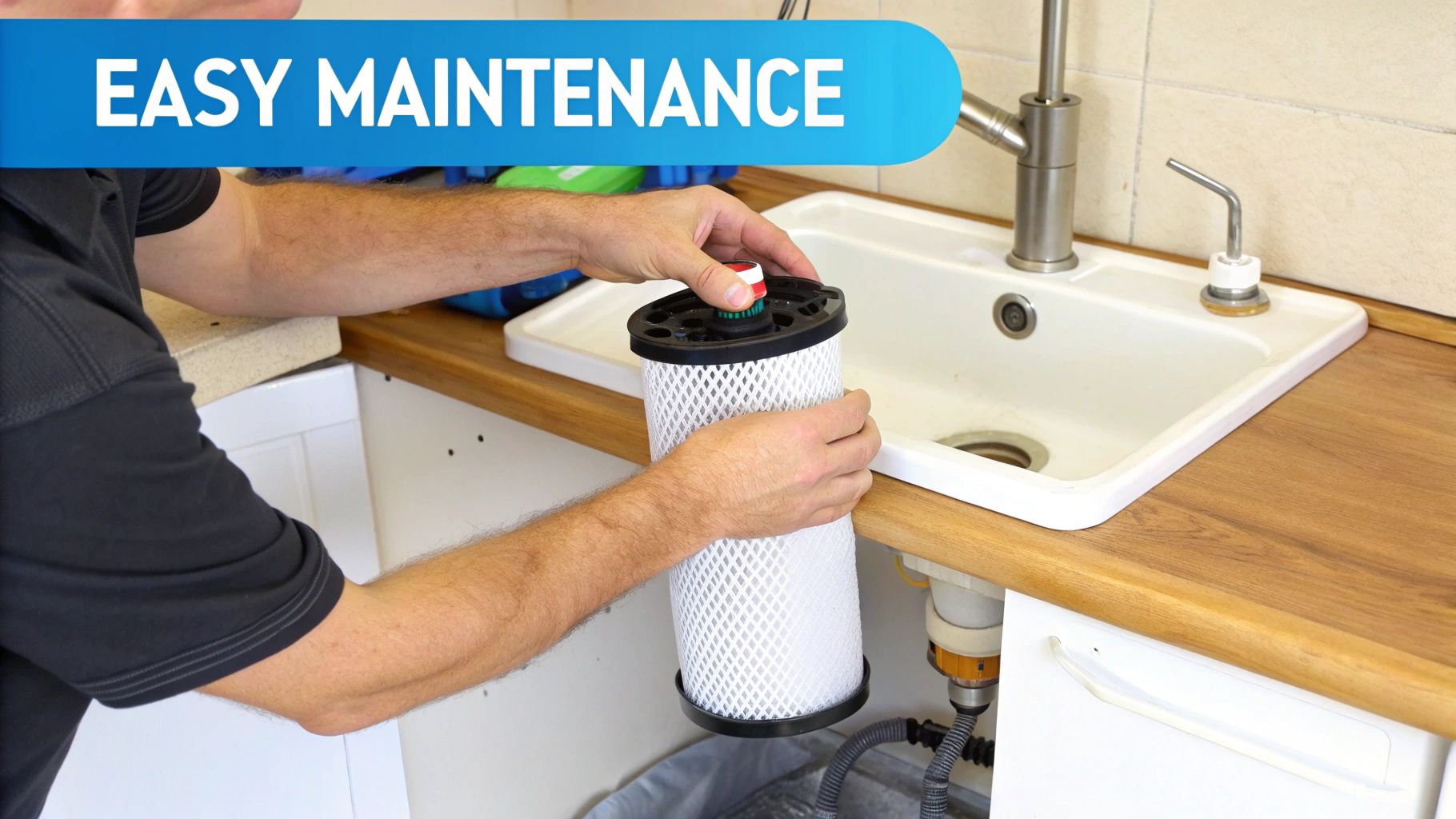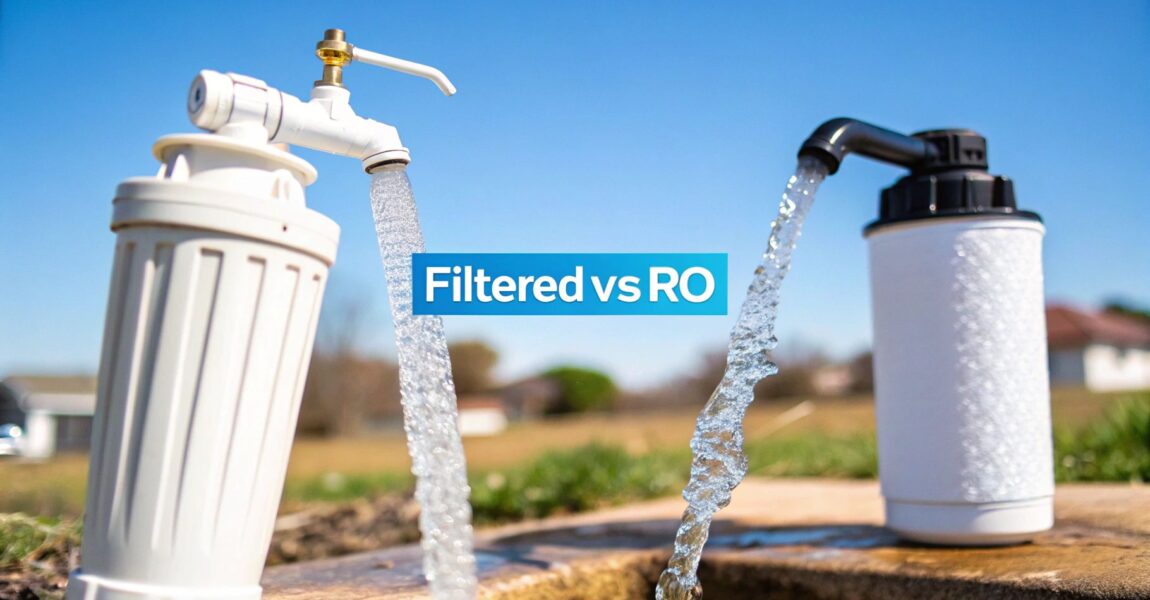
Filtered Water vs Reverse Osmosis: Which Is Right for Your Home?
Trying to pick the right water filter for your home? It’s a classic showdown that usually boils down to choosing between a standard filter and a reverse osmosis system. They both promise cleaner water, but they go about it in wildly different ways.
So what's the short answer? Standard filters are perfect for a quick and easy upgrade to your tap water's taste and smell, getting rid of annoyances like chlorine. On the other hand, reverse osmosis systems are the heavy hitters, providing a much more intense level of purification that strips out nearly everything—we're talking dissolved salts, lead, and even fluoride.
Choosing Your Home Water Filtration System
This guide is here to walk you through exactly what each technology does. We’ll break down what they remove, how much they cost, and which system really makes sense for your kitchen. The goal is to give you the confidence to pick the best option for your family's health and hydration.
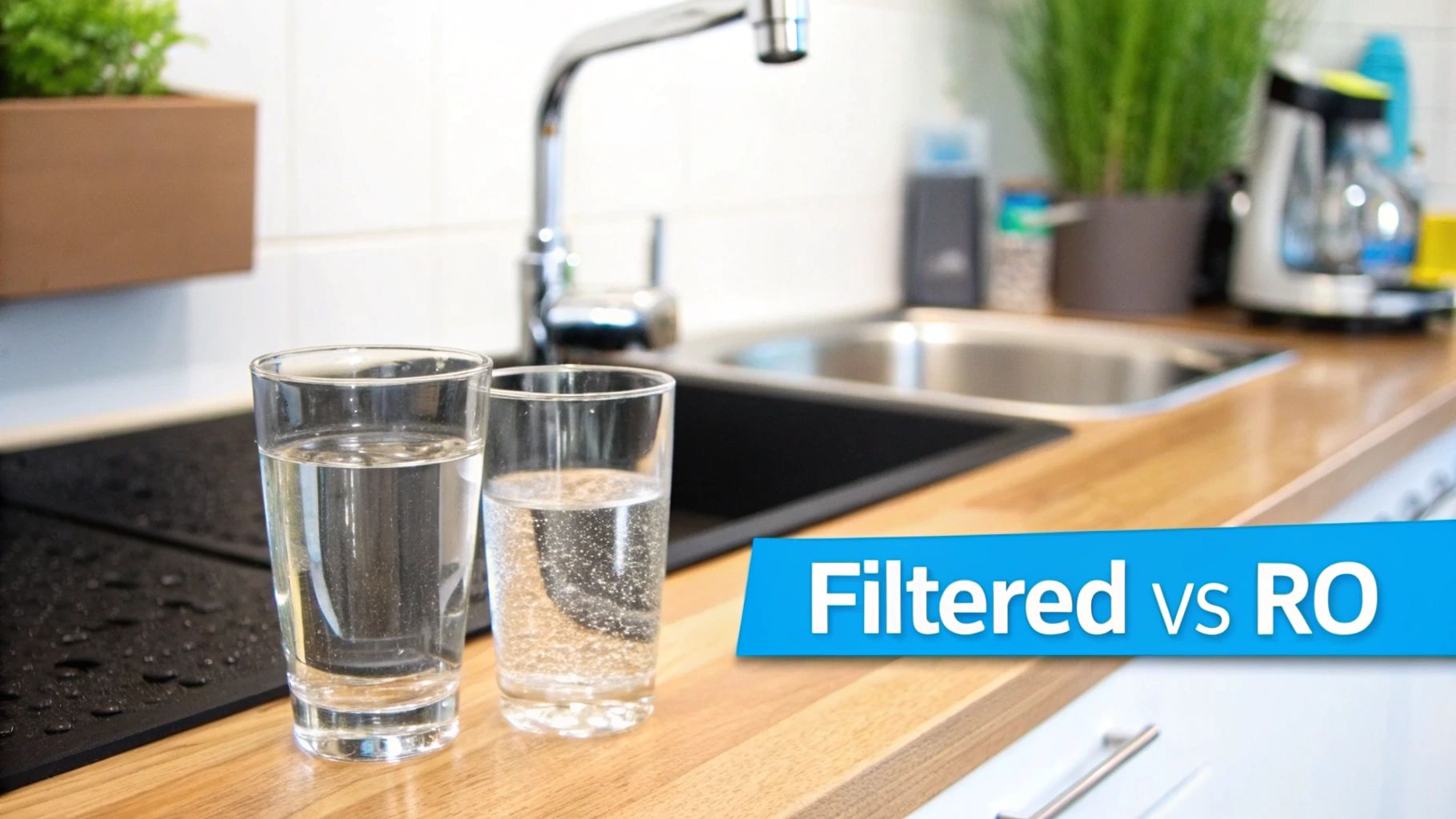
When you think "filtered water," you probably picture a simple pitcher in your fridge or a small filter clicked onto your faucet. These are incredibly popular for a reason—they work great for improving the basic quality of city water. Most of them rely on activated carbon to tackle those aesthetic issues, making your water much more enjoyable to drink.
A Reverse Osmosis (RO) system is a different beast altogether. It's a more comprehensive setup, usually installed under your kitchen sink. It pushes water through a multi-stage process, with a special membrane at its core, to remove a significantly wider range of contaminants. For those curious about specific faucet options, this overview of BRITA integrated water filter taps provides a great deep dive into how those particular systems work.
To get a quick handle on the key differences, it helps to see them side-by-side.
Filtered Water vs Reverse Osmosis at a Glance
This table lays out the core distinctions between standard filters and RO systems. Think of it as your cheat sheet before we dive into the nitty-gritty.
| Feature | Standard Water Filter (e.g., Carbon) | Reverse Osmosis (RO) System |
|---|---|---|
| Primary Goal | Improves taste and odor by removing chlorine. | Comprehensive purification, removing up to 99% of contaminants. |
| Key Technology | Activated carbon adsorption. | A semi-permeable membrane that blocks dissolved solids. |
| Contaminants Removed | Chlorine, some VOCs, sediment, bad tastes/smells. | Lead, arsenic, fluoride, dissolved salts, pesticides, and more. |
| Installation | Very easy (pitchers) to simple DIY (faucet). | Moderate DIY, may require a plumber for under-sink models. |
| Cost | Low upfront cost, frequent filter replacements. | Higher initial cost, less frequent but pricier replacements. |
As you can see, the choice isn't just about "better" filtration—it's about matching the right technology to your specific needs, budget, and water quality concerns at home.
How Standard Water Filters Improve Your Tap Water
When most people talk about "filtered water" at home, they're usually thinking of the common, easy-to-use filters that tackle specific water problems. These standard filters are your first line of defense against the usual suspects that give tap water that off-putting taste or smell. Think of them as specialists, not generalists—they're built for quick, noticeable improvements, not total purification.
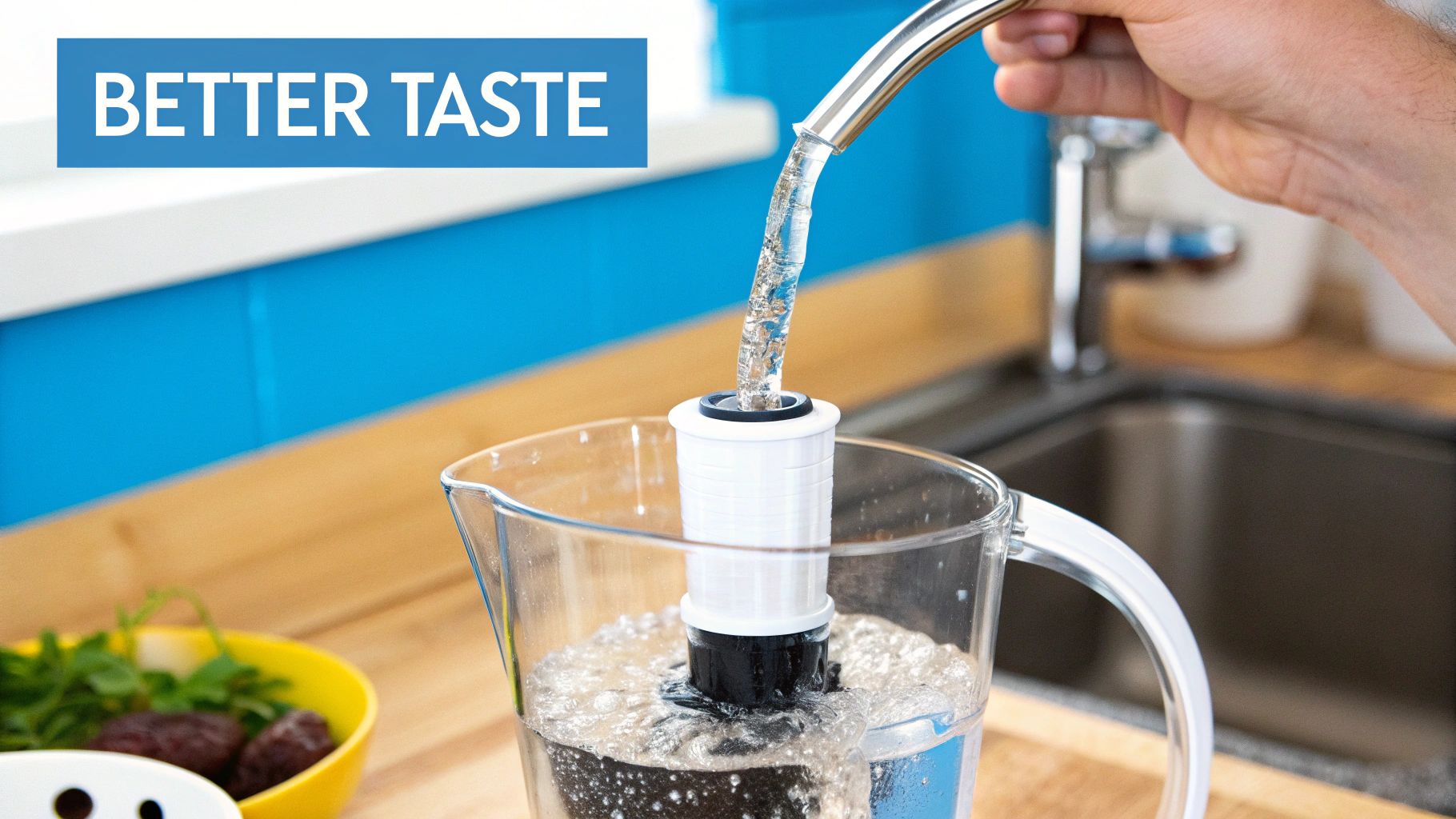
The secret sauce for most of these filters is activated carbon. It’s pretty amazing stuff. Imagine a super-porous sponge with a massive internal surface area. To put it in perspective, just a single gram of activated carbon can have a surface area bigger than a football field. That structure makes it an incredibly effective magnet for certain contaminants.
The Power of Activated Carbon
Activated carbon works its magic through a process called adsorption. This is where impurities chemically latch onto the carbon's surface rather than being physically strained out. It’s an incredibly effective method for grabbing the specific things that mess with taste and odor, which is why you’ll find it in almost every home water filter.
Here's what it's best at nabbing:
- Chlorine: This is the big one. Your city water treatment plant adds chlorine to kill germs, but it often leaves behind a strong chemical taste and smell. Activated carbon is a champ at adsorbing chlorine, which is why your water tastes so much better right away.
- Volatile Organic Compounds (VOCs): These are chemicals from industrial sources and solvents that can sometimes seep into the water supply. A good carbon filter can pull many of them out.
- Pesticides and Herbicides: Small traces from agricultural runoff can also be caught on the carbon's surface.
By zeroing in on these contaminants, a simple carbon filter in a pitcher or screwed onto your faucet can take your drinking water from just "drinkable" to genuinely "enjoyable." It's a targeted fix for a very common household complaint.
Key Takeaway: Standard filters lean heavily on activated carbon to make your tap water taste and smell better. They’re great for chlorine but aren't designed to remove the tough stuff like lead or fluoride.
Beyond Carbon: Sediment and Specialty Filters
While carbon is the star of the show, it often works with a supporting cast, especially in more serious under-sink or whole-house systems. Another common player is the sediment filter, which acts more like a simple screen or sieve.
Sediment filters are all about catching physical debris. Think of them as the bouncer at the club, stopping the big, clunky stuff from getting in.
Their job is to block:
- Rust flakes from old, aging pipes
- Sand, silt, and dirt from the water main
- Any other visible gunk
These filters are absolutely crucial for protecting the more delicate filtration stages that come after them, whether that's a carbon filter or the high-tech membrane in a reverse osmosis system. By trapping all that grit, they keep things from getting clogged and help the whole system last longer.
This kind of specialization is what really defines standard filtration. You have a carbon filter adsorbing chlorine and a sediment filter blocking rust—each piece has a specific job. This is the heart of the filtered water vs. reverse osmosis debate; one improves, the other purifies.
What's Going On Inside a Reverse Osmosis System?
If you think a standard water filter is doing a lot, a reverse osmosis (RO) system is on a whole other level. This isn't just about filtering out the obvious stuff; it's a deep-clean purification process that literally takes your water apart, scrubs it clean of almost everything, and then puts it back together for drinking.
Think of it less like a simple screen and more like a high-tech water treatment plant shrunk down to fit under your sink. Every drop of water goes through a rigorous, multi-stage journey, which is what really separates RO from a basic pitcher or faucet filter.
The Multi-Stage Journey of Your Water
The real power of reverse osmosis comes from its methodical, step-by-step approach. Your tap water doesn't just hit one filter and call it a day. It has to pass through a series of checkpoints, each designed to tackle a different problem and protect the next stage down the line.
It all kicks off with pre-filtration. Before the water even gets close to the main event, it has to get past the bouncers. These usually include:
- A Sediment Filter: This is the first line of defense, acting as a physical net to catch the big gunk. It snags rust flakes, sand, silt, and any other grit that could jam up the more sensitive parts of the system.
- A Carbon Filter: Next, the water moves through an activated carbon filter. Just like the ones in standard systems, this filter's job is to grab onto chlorine and other chemicals. This is crucial because chlorine can actually eat away at the delicate RO membrane.
These pre-filters are the unsung heroes of the operation. They're the bodyguards that make sure the star of the show can do its job properly.
The Heart of the System: The RO Membrane
Once the pre-filtering is done, the real magic happens. The water is pushed at high pressure up against a semi-permeable membrane. This is a special material with pores so tiny—around 0.0001 microns—that they’re almost impossible to imagine.
These microscopic holes are just big enough for H₂O molecules to squeeze through, but they slam the door on almost everything else. This is where an RO system leaves other filters in the dust.
An RO membrane is an incredible barrier, capable of kicking out up to 99% of all total dissolved solids (TDS). We’re talking about heavy metals like lead and arsenic, inorganic minerals like fluoride, and dissolved salts that breeze right through simpler carbon filters.
After the water has been forced through the membrane, it’s collected in a small storage tank. But there’s one final step. Right before it comes out of your special RO faucet, the water gets a final once-over from a post-carbon filter. This last filter acts as a "polisher," wiping away any lingering off-tastes or smells the water might have picked up in the tank. The result is water that's not just clean, but noticeably crisp and fresh.
This technology is so effective it's become a massive force in the global water filtration world. According to Mordor Intelligence, its ability to remove such a huge range of contaminants makes it a go-to solution for ensuring water safety in homes everywhere. It's this tough, multi-stage process that makes RO the heavyweight champion for anyone serious about getting incredibly pure drinking water.
A Detailed Contaminant Removal Comparison
When you're trying to choose between filtered water and reverse osmosis, it really comes down to one question: what does each system actually take out of my water? This is where the two go their separate ways. Think of standard filters as specialists, while reverse osmosis systems are the all-in-one purifiers designed to catch pretty much everything.
This difference is a big deal. With concerns about water quality growing, effective home filtration has become a top priority for families everywhere. The global market for water purifiers is booming, and RO filters are leading the pack simply because of how well they perform.
What Standard Filters Are Good At
Standard filters, especially the ones using activated carbon, are fantastic for making your water taste and smell better. They go after the common stuff that makes tap water unappealing.
Here’s what they tackle best:
- Chlorine: This is the #1 job for carbon filters. They're great at absorbing the chlorine from city water treatment, which gets rid of that "swimming pool" odor and taste almost instantly.
- Volatile Organic Compounds (VOCs): These filters can catch certain industrial chemicals and solvents that might be lingering in your water supply.
- Bad Tastes and Odors: By grabbing chlorine and some other organic compounds, carbon filters make your water taste crisp and clean.
But it's crucial to know what they don't do. Standard filters can't remove dissolved solids. That means things like heavy metals, fluoride, arsenic, and nitrates slide right past the carbon and stay in your glass.
The Full-Spectrum Power of Reverse Osmosis
A reverse osmosis (RO) system is a whole different beast. It purifies water on another level, using a multi-stage process to strip out a huge list of contaminants that standard filters can’t even touch.
This diagram gives you a great visual of how water moves through an RO system—from the initial pre-filters, through the powerhouse membrane, and to a final post-filter.
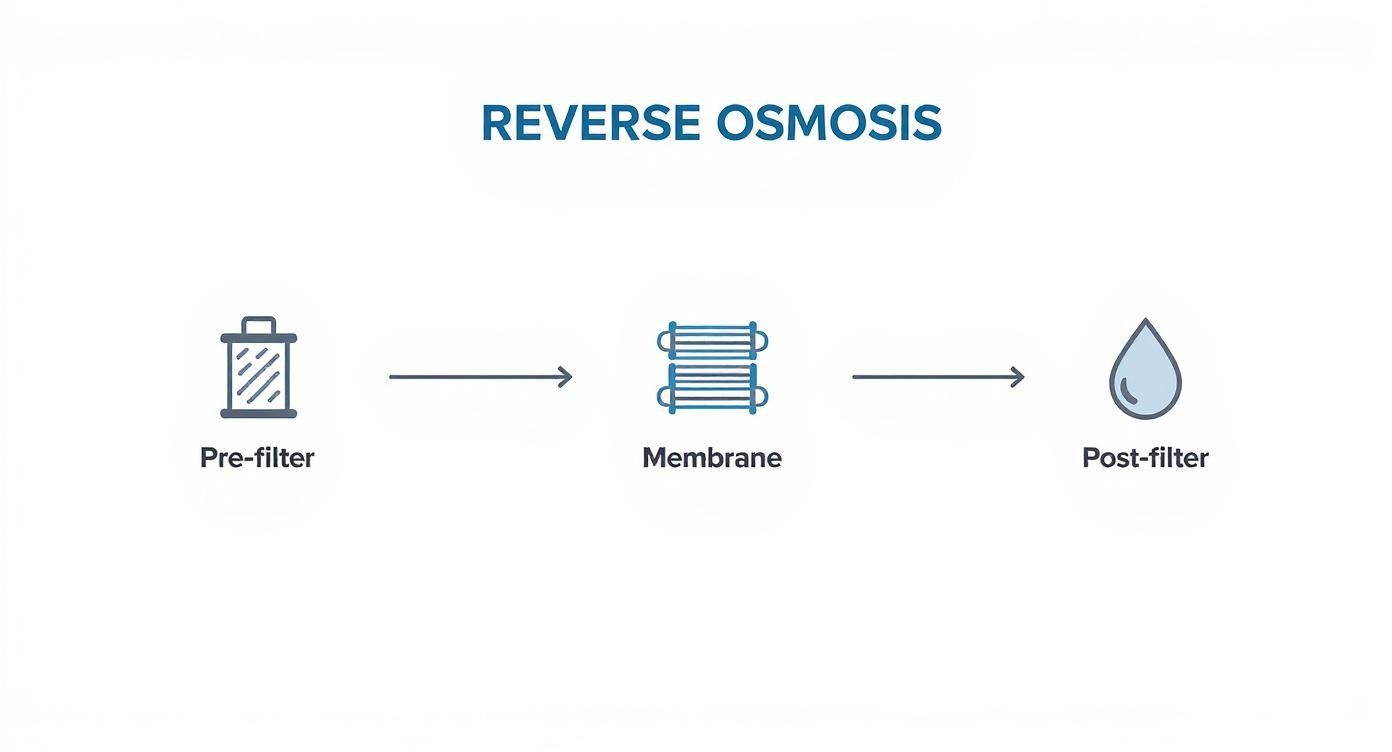
Each stage has a specific role, but the RO membrane is the star of the show, separating pure water molecules from nearly everything else.
The secret is the semi-permeable membrane at the heart of the system. Its pores are incredibly tiny—about 0.0001 microns—so they block almost anything that isn't a water molecule.
An RO system’s real claim to fame is its ability to remove up to 99% of Total Dissolved Solids (TDS). This is a massive category that includes some of the most serious health concerns, many of which you can't see, taste, or smell.
Contaminant Removal Head-to-Head
Let's put them side-by-side to see where RO really shines.
| Contaminant Concern | Standard Filter (Activated Carbon) | Reverse Osmosis System | The Bottom Line |
|---|---|---|---|
| Chlorine | Excellent | Excellent (via pre-filter) | Both are great for fixing this common taste and smell problem. |
| Lead & Heavy Metals | Limited / None | Excellent | RO is the clear winner for removing lead, arsenic, mercury, and other metals. |
| Fluoride | Ineffective | Excellent | If you want to remove fluoride, an RO membrane is the only reliable way. |
| Nitrates & Sulfates | Ineffective | Excellent | These dissolved salts get right through carbon but are stopped by an RO membrane. |
| Bacteria & Viruses | Ineffective | Highly Effective | The pores in an RO membrane are just too small for microorganisms to get through. |
| Total Dissolved Solids (TDS) | No Reduction | Excellent (up to 99%) | This is the key difference. RO cleans water at the molecular level. |
Seeing it laid out like this makes the decision much simpler. If your main goal is just to improve the taste of your city water, a standard filter is a solid, budget-friendly choice. But if you're worried about specific health-related contaminants like lead, fluoride, or arsenic—or you just want the purest water possible—a reverse osmosis system is hands-down the best option for your home. It delivers a level of confidence that standard filters just can't offer.
Comparing Cost, Maintenance, and Installation
Let's get practical. Beyond what a filter actually removes from your water, the real-world factors of cost, upkeep, and setup are often what seal the deal. This is where the filtered water vs. reverse osmosis debate really heats up, because the right choice for your home has to balance the upfront investment with long-term effort and expenses.
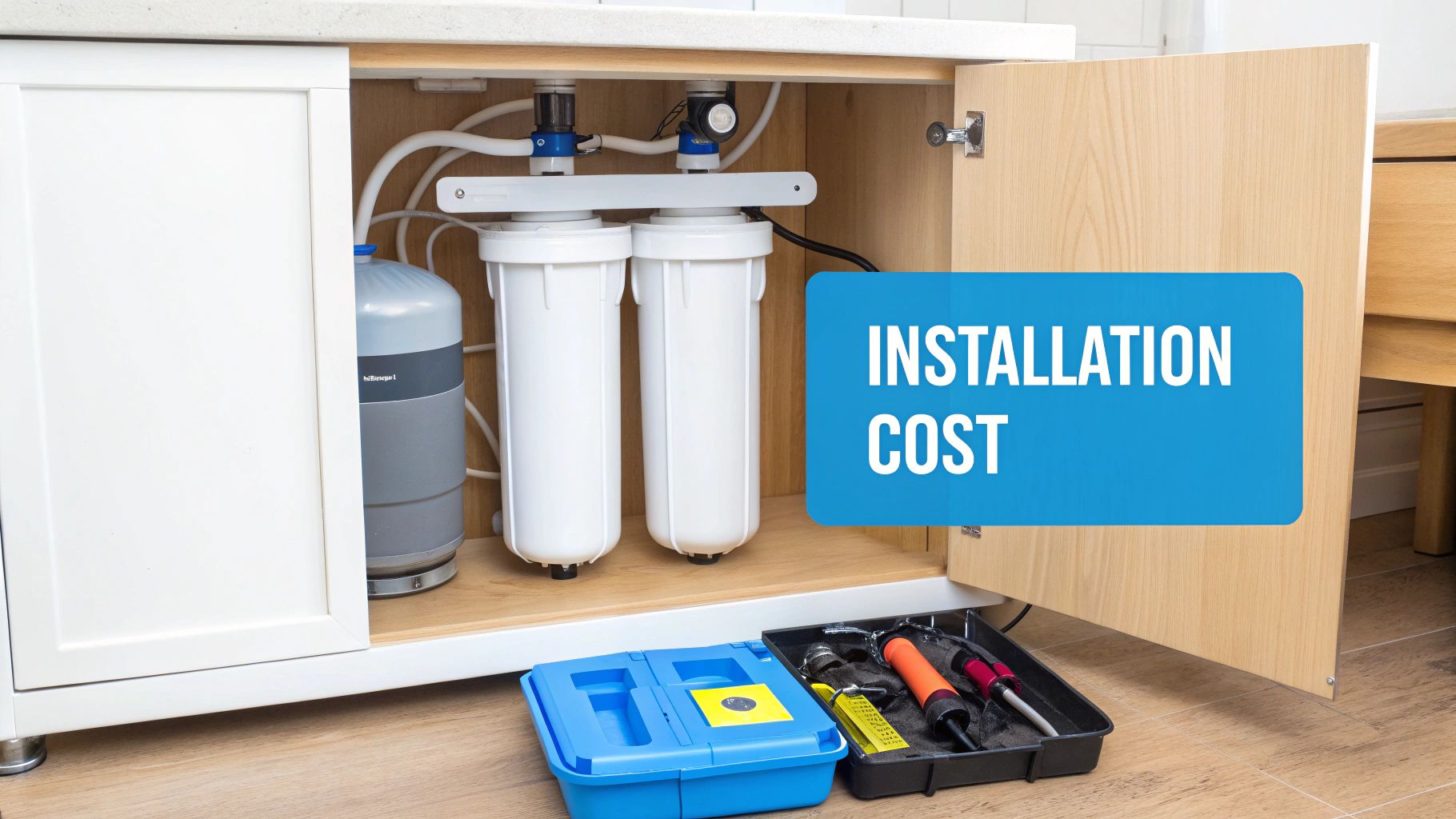
Standard filters, like the pitcher in your fridge or a simple faucet attachment, are incredibly easy to get started with. You can grab one for as little as $20-$50, making them a super accessible first step toward better water. The catch? Their true cost is hidden in the constant, recurring expense of replacement filters, which can absolutely pile up over a year.
On the other side of the ring, reverse osmosis (RO) systems are a more serious initial investment. You’re typically looking at $150 to over $500 for a solid under-sink model. While that stings a bit more upfront, the ongoing maintenance is usually more predictable. The workhorse RO membrane can last for 2-4 years, spreading that cost out over a much longer timeline.
Upfront vs. Long-Term Financials
You have to look at the total cost of ownership, not just the price tag on the box.
That simple water pitcher might seem like a bargain, but if you're replacing its $15 filter every two months, you're spending $90 a year. Fast forward three years, and you've sunk $270 into a solution that only filters water for one pitcher at a time.
Now, let's look at an under-sink RO system that costs $250 to buy. Its annual filter kits—for the sediment and carbon pre-filters—usually run about $60-$80. The main RO membrane, which costs around $50-$100, only needs to be swapped out every few years. When you do the math, RO often becomes the more cost-effective choice for truly pure drinking water in the long run.
Thinking about the long-term care of a water system is a lot like other home improvement projects. It's smart to see it as part of your overall upkeep strategy, similar to the other essential home maintenance tips that keep your house running smoothly.
Installation and Upkeep Demands
The setup experience couldn't be more different between standard filters and RO systems. It’s the classic trade-off: simplicity for performance.
- Standard Filters: A water pitcher requires zero installation—just unbox it, rinse the filter, and fill it up. Faucet and countertop filters are also built for a quick DIY setup, usually taking just a few minutes with no special tools required.
- Reverse Osmosis Systems: Most under-sink RO units are designed for a handy homeowner to install. It involves tapping into the cold water line, drilling a small hole in your countertop for a dedicated faucet, and connecting a line to the drain. It’s definitely a more involved project, but totally manageable if you’re comfortable with basic tools.
The Installation Verdict: If you're renting or just want an immediate, no-fuss fix, standard filters are the hands-down winner. But for homeowners willing to tackle a straightforward plumbing project for far superior water quality, an under-sink RO system is a rewarding and permanent upgrade.
What About the Water Waste?
One of the biggest knocks against reverse osmosis has always been water waste. And it’s true—early models were horribly inefficient, sending gallons of water down the drain for every gallon of pure water they produced. But this is one area where the technology has made huge leaps.
Modern, high-efficiency RO systems have drastically improved their game. We've come a long way from the old days where a system might waste three or more gallons for every one it purified. Thanks to better membrane technology, some newer systems have drastically cut down on waste water, making them far more efficient.
This makes today's RO a much more responsible and sustainable choice for any eco-conscious homeowner.
Making the Right Choice for Your Home
Choosing between standard filtered water and reverse osmosis really boils down to your specific situation. We’ve gone through the tech and the costs, but now it's time to connect that to the reality of your kitchen sink. The "best" choice isn't about which system is superior on paper, but which one truly fits your home, your water, and your lifestyle.
To simplify things, let’s walk through a few common household scenarios. Your own needs will almost always point you straight to the right solution.
Matching the System to Your Home
Take a moment to think about your living situation and what your main worries are about your water. The right answer usually becomes obvious when you look at it this way.
-
For the Renter or College Student: You need a portable, no-installation fix to make your water taste better. A simple pitcher or faucet filter is perfect. They give you immediate results for chlorine and odors without making any permanent changes to the plumbing.
-
For the Suburban Family on City Water: You generally trust your municipal supply for safety but worry about hidden stuff like lead from old pipes or trace industrial chemicals. An under-sink reverse osmosis system is your strongest move for targeted, high-level purification right where you get your drinking and cooking water.
-
For the Homeowner with Well Water: If you're on a private well, you are 100% responsible for your water's safety. Well water can have a huge range of unknown contaminants like nitrates, arsenic, and bacteria. In this case, a reverse osmosis system is almost always the go-to recommendation for real peace of mind and comprehensive protection.
The core of the filtered water vs. reverse osmosis debate is this: standard filters improve water, while reverse osmosis systems purify it. Your choice hinges on which of those two things your water actually needs.
A Simple Framework for Your Decision
Feeling a bit overwhelmed? Don't be. You can pick the perfect system with confidence by following three simple steps. This approach cuts through the noise and zeroes in on what actually matters for your family.
-
Test Your Water: You can't fix a problem you don't understand. The first step is always getting a quality water test kit to see exactly what’s in your tap water. This data is the single most critical piece of the puzzle.
-
Evaluate Your Budget: Look at both the upfront price and the long-term cost of replacing filters. A pitcher is cheap to buy, but those filter costs add up. An RO system is a bigger initial investment but usually has more predictable yearly maintenance.
-
Consider Your Installation Capabilities: Be honest with yourself about your DIY comfort level. Are you looking for something you can use right out of the box, or are you okay with a more involved under-sink installation?
For more great tips on choosing a system that works for you, check out the helpful resources in our detailed water filter advice section.
By taking this approach, you move past just comparing specs on a box and instead choose the system that is genuinely the right fit for your home's unique water challenges.
Common Questions About Water Filtration
Even with all the details laid out, you probably still have a few lingering questions. That's perfectly normal. Let's tackle some of the most common ones we hear to help you feel confident in your decision.
Does Reverse Osmosis Remove the Good Minerals Too?
Yes, that's a fair point. An RO membrane is so powerful that it pulls out nearly everything—that includes beneficial minerals like calcium and magnesium right along with the bad stuff. But here's the thing: most people get the vast majority of their essential minerals from a healthy diet, not from their tap water.
If you're still concerned, many modern RO systems have a great solution: an optional remineralization filter. This adds a balanced mix of healthy minerals back into the water right before it comes out of the faucet, which also tends to improve the taste and pH.
How Often Will I Be Changing Filters?
That really depends on the system you choose and how much gunk is in your starting water. It’s a bit of a sliding scale.
- Pitcher Filters: These are the most frequent. You'll be swapping them out every 2-3 months.
- Under-Sink Carbon Filters: These guys last quite a bit longer, usually about 6-12 months.
- Reverse Osmosis Systems: This is a multi-stage process. The first couple of filters (sediment and carbon) need to be changed every 6-12 months. But the core RO membrane is the real workhorse and can last anywhere from 2-4 years.
Always double-check the manufacturer's recommendations. If you have particularly high sediment or heavy usage, you might need to change them a bit sooner. Staying on schedule is the key to keeping your water pure.
Is Installing a Reverse Osmosis System a Huge Hassle?
Honestly, not usually. It's definitely more involved than just filling up a pitcher, but most under-sink RO systems are designed for a homeowner to install themselves. The kits come with everything you need and step-by-step instructions.
You'll basically be connecting a valve to your cold water line, installing a new, dedicated faucet (this might mean drilling a small hole in your countertop), and running a tube to your sink's drain. If you're comfortable with a few basic tools, it's a project you can easily knock out on a Saturday.
At Water Filter Advisor, we want to help you find the right solution for your home. Check out our detailed guides and reviews to make a smart, cost-effective choice for your family at https://www.waterfilteradvisor.com.

